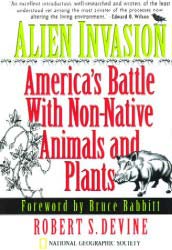Native Plants:
Alien Invasion: America’s Battle With Non-Native Animals and Plants
By Robert Devine
National Geographic Society, Washington, DC, 1998. Hardcover, 288 pages.
Reviewed by Christie Keith
 Gardeners in temperate climates are constantly tempted by beautiful exotics. Lantana, hybrid roses, vinca, the graceful fountain of pampas grass, lawn… the list of foreign beauties we’ve fallen for goes on and on.
Gardeners in temperate climates are constantly tempted by beautiful exotics. Lantana, hybrid roses, vinca, the graceful fountain of pampas grass, lawn… the list of foreign beauties we’ve fallen for goes on and on.
But not all beautiful plants are benign, as Robert Devine recounts in Alien Invasion. From the kudzu-entangled south to the melaleuca-choked Everglades, from a whitefly-crusted Imperial Valley to a cheatgrass-smothered sagebrush prairie, Devine takes us on a guided tour of an America dangerously overrun by plants and animals that our ecology did not evolve to include.
While much of Devine’s call for arms is directed at industry and government, Alien Invasion also contains pleas to gardeners, botanical gardens, nurseries, and growers to consider the consequences of their choices before growing, planting, or distributing a non-native plant.
Devine considers a plant “non-native” if the ecosystem into which it is introduced did not evolve with that plant. While not all non-natives are invasive, most have the potential to become invasive in a way in which native, adapted plants do not. Natural predators and diseases, as well as competition from other plants, in general give exotics a head start in any system, however closed or balanced it might seem at first glance. Some exotics behave well for fifty or a hundred years, before breaking free from constraints and exploding into invasiveness. This leads to the destruction and extinction of all the plants and animals that once lived in the ecosystem that is being replaced by a monoculture of the successful invader.
Some areas, such as Hawaii’s rain forests and California’s oak grasslands, have been almost completely overrun by invasive exotics. Over 90 percent of the grass in our state is European weed grass, imported in the manure of livestock. California’s “golden hills” are not a part of our natural ecology, and the eradication of the many species of native bunchgrasses in favor of sod-forming European grasses has reduced wildflower populations and diversity throughout the oak grasslands.
Those of us who sincerely love our non-native garden plants will be glad to know not all of them are invasive or in any way dangerous. But as stewards of not only our own gardens but the ecosystems they comprise, we need to understand how our choices will affect the birds, mammals, insects, and microscopic life forms that evolved in that patch of dirt we call “ours.” For example, most people in my area wouldn’t dream of planting pampas grass, because we have seen its unsightly incursion into our coastal bluff areas. Most of us know that eucalyptus is a poor choice for our gardens, and several popular native plants adorn nearly every garden in the area.
But Devine encourages us as gardeners to think beyond these details, and contemplate our gardens on an ecosystem level. Joining garden writers such as Sara Stein (Noah’s Garden), Michael Pollan (Second Nature), Stevie Daniels (The Wild Lawn Handbook), Sally Wasowski (Requiem for a Lawnmower), and other ecological garden writers, Devine is not trying to guilt trip us into using native plants, but to change the say we see plants, soil, wildlife, pests, and gardens forever.
Coastal northern California, where I live, is blessed with a varied botany, both native and introduced. Our farmers don’t rely on the huge single crop economies of agribusiness, often to their own financial deteriment. But whether it’s a decision to replace a meadow with a lawn, seed your horse’s pasture with European grasses, or destroy the row of wildflowers sullying the pristine rows of your vegetable garden, all your choices will determine what fungus, what nematode, what bird, what bee, will be attracted to your garden. With the near-extinction of the honeybee, native pollinators have a chance to rebound, but not if we keep killing them off with indiscriminate pesticide spraying and destroying their habitat in the name of “gardening.”
It is not the “non-nativeness” of plants that causes problems, but the havoc their introduction can bring to a healthy ecology. Each plant choice will set off a chain reaction of effects, and Devine implores us to educate ourselves as to what those effects are before ordering that rare plant from the nursery catalogue. He also implores the nurseries not to sell invasive non-natives, and to educate their staffs and their customers as to the consequences of their choices.
Can we ever go back to pristine nature? Of course not. But we can make choices now that will help sustain the diversity and health of our ecologies, and not further diminish the botanical heritage of California and the planet. “Most Americans,” writes Devine, “are not intimate with their native biological communities. We have become estranged from nature and have lost much of our sense of belonging to the natural world. Our sense of being part of the natural world will grow even weaker if we allow alien species to homogenize our distinctive floras and faunas. One biologist coined the term ‘Homogocene’ to describe the new era we are entering. If this era comes to pass, there will be little left of our natural heritage except impoverished habitat and cockroaches, cheatgrass, carp, crows, and the other cosmopolitan generalists that thrive on degradation.”
